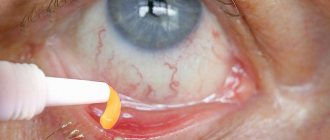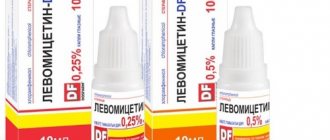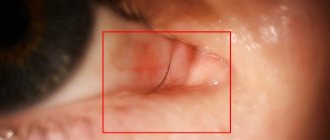Instructions for use
Instructions for using Levomycetin ointment are as follows. It should be applied to the wound once or twice a day (this depends on the extent and extent of the affected area). Apply the ointment in a thick layer, wait a few minutes for it to dry, and apply a bandage.
If the ointment is used to treat cracked nipples, the duration of the course of treatment is from 4 days to a week. The surface is covered with ointment and a sterile bandage.
If the ointment is used to treat eye diseases, then it is placed under the lower eyelid. Before performing the procedure, warm the tube in your hands so that the temperature of the substance increases. The lower eyelid is slightly retracted and a small amount of 1% ointment is placed inside. In order for the substance to be evenly distributed over the surface, the eye should be closed and moved in different directions. After this, the eyes should be closed for at least 5 minutes.
If the patient is diagnosed with keratitis, conjunctivitis or trachoma, a gauze bandage is placed over the eye. Ointment is applied to a small amount of tissue and applied to the eye. The gauze is secured so that it does not move.
Before starting treatment, you can wash your eyes with a very weak solution of potassium permanganate.
Patients who use contact lenses should remove them before using the drug and put them on only half an hour after applying the ointment. The product is applied to the eye 4-5 times a day. How long the course of treatment lasts is determined by the ophthalmologist individually for each patient.
When Levomycetin ointment is used to solve acne problems, a bandage is not applied. The product is applied in a thin layer directly to the affected area.
Since the drug is used only externally, there have been no recorded cases of overdose so far.
Indications for the use of Levomycetin eye drops
Levomycin drops are used for infectious eye diseases caused by microorganisms sensitive to this drug. So, Figures 1–3 show the main types of eye diseases for which this medicine should be used. Among these will be:
conjunctivitis (inflammation of the inner layer of the eyelids - conjunctiva) of infectious origin; keratitis (inflammation of the cornea); blepharitis (inflammation of the eyelids or stye); keratoconjunctivitis.
Eye keratitis
Ophthalmologists also prescribe Levomycetin in cases where other non-steroidal anti-inflammatory ophthalmic drugs are ineffective. It quickly relieves purulent inflammation and cleanses the eyes. This drug is used to treat eye infections in children.
Blepharitis eyes
Levomycetin 0.25% dropper bottle 10ml eye drops
A country
The country of production may vary depending on the batch of goods. Please check with the operator for detailed information when confirming your order.
Compound
Bottle 10 ml
Chloramphenicol 2.5 mg per 1 ml.
pharmachologic effect
Broad-spectrum antibiotic. The mechanism of antimicrobial action is associated with a violation of the synthesis of microbial proteins. Has a bacteriostatic effect. Active against gram-positive bacteria: Staphylococcus spp., Streptococcus spp.; gram-negative bacteria: Neisseria gonorrhoeae, Neisseria meningitidis, Escherichia coli, Haemophilus influenzae, Salmonella spp., Shigella spp., Klebsiella spp., Serratia spp., Yersinia spp., Proteus spp., Rickettsia spp.; also active against Spirochaetaceae and some large viruses. Chloramphenicol is active against strains resistant to penicillin, streptomycin, and sulfonamides. Resistance of microorganisms to chloramphenicol develops relatively slowly.
Indications for use
For oral administration: infectious and inflammatory diseases caused by microorganisms sensitive to chloramphenicol, including: typhoid fever, paratyphoid fever, dysentery, brucellosis, tularemia, whooping cough, typhus and other rickettsioses; trachoma, pneumonia, meningitis, sepsis, osteomyelitis. For external use: purulent skin lesions, boils, long-term non-healing trophic ulcers, second and third degree burns, cracked nipples in nursing women. For local use in ophthalmology: inflammatory eye diseases.
Mode of application
Levomycetin eye drops (DIA, Akri, AKOS, Ferein) are applied into the conjunctival sac of each eye, one 3-4 times a day. The course of treatment usually lasts from 5 to 15 days. When using the drug, you should tilt your head back, gently pull the lower eyelid towards the cheek so that a cavity is formed between the skin and the surface of the eye, and, without touching the eyelid and the surface of the eye with the tip of the dropper bottle, add 1 drop of the medicine into it. After instillation, press the outer corner of the eye with a finger and do not blink for 30 seconds. If you cannot avoid blinking, you need to do this as carefully as possible so that the solution does not spill out of the eye. For children during the neonatal period (the first 28 days after birth), the drug is used for health reasons. For purulent otitis, the drug is injected into the ear 1-2 times a day. 2-3 drops each. If there is significant discharge from the ear canal that washes away the applied solution, Levomycetin can be used up to 4 times a day. For bacterial rhinitis, your doctor may recommend using nasal drops.
Interaction
With the simultaneous use of chloramphenicol with oral hypoglycemic drugs, an increase in the hypoglycemic effect is observed due to the suppression of the metabolism of these drugs in the liver and an increase in their concentration in the blood plasma. When used simultaneously with drugs that inhibit bone marrow hematopoiesis, there is an increased inhibitory effect on the bone marrow. When used simultaneously with erythromycin, clindamycin, lincomycin, a mutual weakening of the effect is observed due to the fact that chloramphenicol can displace these drugs from the bound state or prevent their binding to the 50S subunit of bacterial ribosomes. When used simultaneously with penicillins, chloramphenicol counteracts the bactericidal effect of penicillin. Chloramphenicol suppresses the cytochrome P450 enzyme system, therefore, when used simultaneously with phenobarbital, phenytoin, warfarin, a weakening of the metabolism of these drugs, a slower elimination and an increase in their concentration in the blood plasma are observed.
Side effect
From the hematopoietic system: thrombocytopenia, leukopenia, agranulocytosis, aplastic anemia. From the digestive system: nausea, vomiting, diarrhea, flatulence. From the central nervous system and peripheral nervous system: peripheral neuritis, optic neuritis, headache, depression, confusion, delirium, visual and auditory hallucinations. Allergic reactions: skin rash, urticaria, angioedema. Local reactions: irritant (for external or local use).
Contraindications
Blood diseases, severe liver dysfunction, deficiency of the enzyme glucose-6-phosphate dehydrogenase, skin diseases (psoriasis, eczema, fungal diseases), pregnancy, lactation, children under 4 weeks (newborns), hypersensitivity to chloramphenicol, thiamphenicol, azidamphenicol.
Use in children Chloramphenicol is not used in newborns, because the development of “gray syndrome” is possible (flatulence, nausea, hypothermia, gray-blue skin color, progressive cyanosis, dyspnea, cardiovascular failure).
Overdose
Severe complications from hematopoiesis are usually associated with long-term use of doses exceeding 3 g/day. Symptoms of chronic intoxication: pale skin, hyperthermia, sore throat, hemorrhages and bleeding, fatigue or weakness. Treatment with high doses of newborns can provoke the development of cardiovascular (“gray”) syndrome, the main signs of which are: - change in skin color to bluish-gray; - hypothermia; - bloating; - vomit; - lack of nervous reactions; - breathing rhythm disturbance; - acidosis; - circulatory collapse; - cardiovascular failure; - coma. In 2 out of 5 cases the patient dies. The cause of death is the accumulation of the drug in the body due to the immaturity of liver enzymes and the direct toxic effect of floramphenicol on the myocardium. Cardiovascular syndrome occurs when plasma concentrations of chloramphenicol exceed 50 mcg/ml.
special instructions
Chloramphenicol is not used in newborns, because the development of “gray syndrome” is possible (flatulence, nausea, hypothermia, gray-blue skin color, progressive cyanosis, dyspnea, cardiovascular failure). Use with caution in patients who have previously received treatment with cytotoxic drugs or radiation therapy. With simultaneous intake of alcohol, a disulfiram-like reaction may develop (skin hyperemia, tachycardia, nausea, vomiting, reflex cough, convulsions). During treatment, systematic monitoring of peripheral blood patterns is necessary.
Side effects and contraindications
Veterinarians are well aware that, of all pets, it is cats that tolerate Levomycetin especially hard. Side effects during treatment may occur from:
- circulatory system (bleeding, hemorrhage, disruption of hematopoietic processes, the worst option is aplastic anemia);
- nervous system;
- liver;
- kidneys (swelling during treatment with Levomycetin occurs very often);
- gastrointestinal tract (diarrhea, which is a symptom of an intestinal infection, can also occur as a reaction to chloramphenicol).
Important! If the course of treatment with Levomycetin exceeds 10 days, the animal must be prescribed a weekly detailed blood test, and if negative dynamics are detected, the drug is stopped.
The following may indicate that an animal reacts poorly to Levomycetin:
- excessive salivation;
- weakness;
- an increase or, conversely, a sharp decrease in body temperature;
- painful swallowing;
- vomit;
- breathing problems;
- decreased speed of nervous reactions;
- the appearance of a gray tint on the mucous membranes or skin (especially noticeable in sphinxes and other similar breeds);
- impaired hearing, vision, changes in taste reactions.
If suspicious symptoms occur, treatment should be stopped.
Generally accepted contraindications to the use of Levomycetin are:
- individual intolerance to chloramphenicol (if the cat is prone to allergies, it is better not to prescribe the drug);
- problems with hematopoiesis;
- renal or hepatic dysfunction, other chronic diseases of these organs;
- some specific internal diseases (for example, deficiency of glucose-6-phosphate dehydrogenase disorder);
- simultaneous use of certain other medications, in particular antibacterial, antitumor, antiepileptic;
- period of pregnancy and lactation;
- children and the elderly (it is undesirable to prescribe Levomycetin to kittens, the same applies to old and weakened animals).











